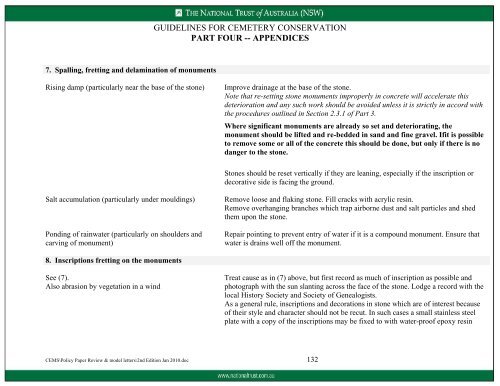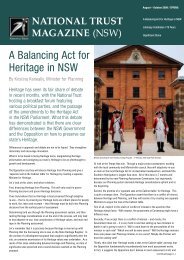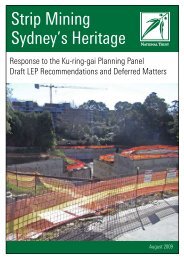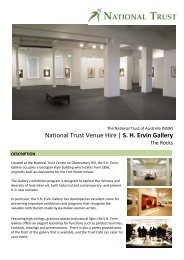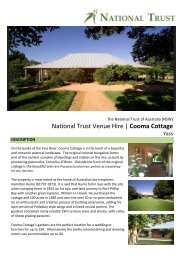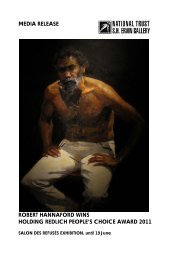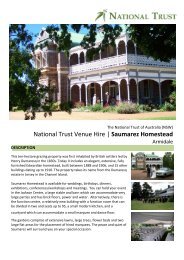Guidelines for Cemetery Conservation - National Trust of Australia
Guidelines for Cemetery Conservation - National Trust of Australia
Guidelines for Cemetery Conservation - National Trust of Australia
You also want an ePaper? Increase the reach of your titles
YUMPU automatically turns print PDFs into web optimized ePapers that Google loves.
GUIDELINES FOR CEMETERY CONSERVATION<br />
PART FOUR -- APPENDICES<br />
7. Spalling, fretting and delamination <strong>of</strong> monuments<br />
Rising damp (particularly near the base <strong>of</strong> the stone)<br />
Improve drainage at the base <strong>of</strong> the stone.<br />
Note that re-setting stone monuments improperly in concrete will accelerate this<br />
deterioration and any such work should be avoided unless it is strictly in accord with<br />
the procedures outlined in Section 2.3.1 <strong>of</strong> Part 3.<br />
Where significant monuments are already so set and deteriorating, the<br />
monument should be lifted and re-bedded in sand and fine gravel. Ifit is possible<br />
to remove some or all <strong>of</strong> the concrete this should be done, but only if there is no<br />
danger to the stone.<br />
Stones should be reset vertically if they are leaning, especially if the inscription or<br />
decorative side is facing the ground.<br />
Salt accumulation (particularly under mouldings)<br />
Ponding <strong>of</strong> rainwater (particularly on shoulders and<br />
carving <strong>of</strong> monument)<br />
Remove loose and flaking stone. Fill cracks with acrylic resin.<br />
Remove overhanging branches which trap airborne dust and salt particles and shed<br />
them upon the stone.<br />
Repair pointing to prevent entry <strong>of</strong> water if it is a compound monument. Ensure that<br />
water is drains well <strong>of</strong>f the monument.<br />
8. Inscriptions fretting on the monuments<br />
See (7).<br />
Also abrasion by vegetation in a wind<br />
Treat cause as in (7) above, but first record as much <strong>of</strong> inscription as possible and<br />
photograph with the sun slanting across the face <strong>of</strong> the stone. Lodge a record with the<br />
local History Society and Society <strong>of</strong> Genealogists.<br />
As a general rule, inscriptions and decorations in stone which are <strong>of</strong> interest because<br />
<strong>of</strong> their style and character should not be recut. In such cases a small stainless steel<br />
plate with a copy <strong>of</strong> the inscriptions may be fixed to with water-pro<strong>of</strong> epoxy resin<br />
CEMS\Policy Paper Review & model letters\2nd Edition Jan 2010.doc 132


